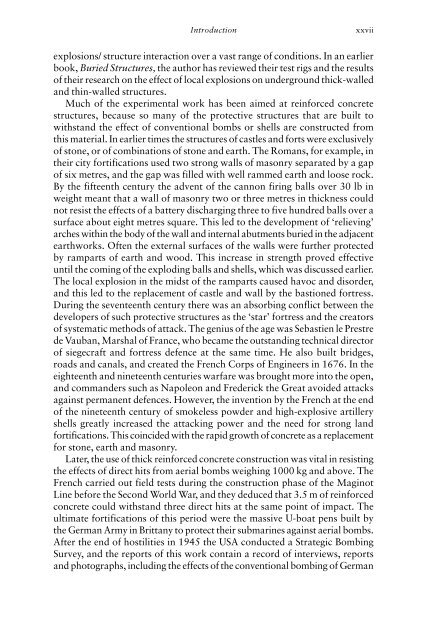A History of Research and a Review of Recent Developments
A History of Research and a Review of Recent Developments
A History of Research and a Review of Recent Developments
You also want an ePaper? Increase the reach of your titles
YUMPU automatically turns print PDFs into web optimized ePapers that Google loves.
Introduction xxvii<br />
explosions/ structure interaction over a vast range <strong>of</strong> conditions. In an earlier<br />
book, Buried Structures, the author has reviewed their test rigs <strong>and</strong> the results<br />
<strong>of</strong> their research on the effect <strong>of</strong> local explosions on underground thick-walled<br />
<strong>and</strong> thin-walled structures.<br />
Much <strong>of</strong> the experimental work has been aimed at reinforced concrete<br />
structures, because so many <strong>of</strong> the protective structures that are built to<br />
withst<strong>and</strong> the effect <strong>of</strong> conventional bombs or shells are constructed from<br />
this material. In earlier times the structures <strong>of</strong> castles <strong>and</strong> forts were exclusively<br />
<strong>of</strong> stone, or <strong>of</strong> combinations <strong>of</strong> stone <strong>and</strong> earth. The Romans, for example, in<br />
their city fortifications used two strong walls <strong>of</strong> masonry separated by a gap<br />
<strong>of</strong> six metres, <strong>and</strong> the gap was filled with well rammed earth <strong>and</strong> loose rock.<br />
By the fifteenth century the advent <strong>of</strong> the cannon firing balls over 30 lb in<br />
weight meant that a wall <strong>of</strong> masonry two or three metres in thickness could<br />
not resist the effects <strong>of</strong> a battery discharging three to five hundred balls over a<br />
surface about eight metres square. This led to the development <strong>of</strong> ‘relieving’<br />
arches within the body <strong>of</strong> the wall <strong>and</strong> internal abutments buried in the adjacent<br />
earthworks. Often the external surfaces <strong>of</strong> the walls were further protected<br />
by ramparts <strong>of</strong> earth <strong>and</strong> wood. This increase in strength proved effective<br />
until the coming <strong>of</strong> the exploding balls <strong>and</strong> shells, which was discussed earlier.<br />
The local explosion in the midst <strong>of</strong> the ramparts caused havoc <strong>and</strong> disorder,<br />
<strong>and</strong> this led to the replacement <strong>of</strong> castle <strong>and</strong> wall by the bastioned fortress.<br />
During the seventeenth century there was an absorbing conflict between the<br />
developers <strong>of</strong> such protective structures as the ‘star’ fortress <strong>and</strong> the creators<br />
<strong>of</strong> systematic methods <strong>of</strong> attack. The genius <strong>of</strong> the age was Sebastien le Prestre<br />
de Vauban, Marshal <strong>of</strong> France, who became the outst<strong>and</strong>ing technical director<br />
<strong>of</strong> siegecraft <strong>and</strong> fortress defence at the same time. He also built bridges,<br />
roads <strong>and</strong> canals, <strong>and</strong> created the French Corps <strong>of</strong> Engineers in 1676. In the<br />
eighteenth <strong>and</strong> nineteenth centuries warfare was brought more into the open,<br />
<strong>and</strong> comm<strong>and</strong>ers such as Napoleon <strong>and</strong> Frederick the Great avoided attacks<br />
against permanent defences. However, the invention by the French at the end<br />
<strong>of</strong> the nineteenth century <strong>of</strong> smokeless powder <strong>and</strong> high-explosive artillery<br />
shells greatly increased the attacking power <strong>and</strong> the need for strong l<strong>and</strong><br />
fortifications. This coincided with the rapid growth <strong>of</strong> concrete as a replacement<br />
for stone, earth <strong>and</strong> masonry.<br />
Later, the use <strong>of</strong> thick reinforced concrete construction was vital in resisting<br />
the effects <strong>of</strong> direct hits from aerial bombs weighing 1000 kg <strong>and</strong> above. The<br />
French carried out field tests during the construction phase <strong>of</strong> the Maginot<br />
Line before the Second World War, <strong>and</strong> they deduced that 3.5 m <strong>of</strong> reinforced<br />
concrete could withst<strong>and</strong> three direct hits at the same point <strong>of</strong> impact. The<br />
ultimate fortifications <strong>of</strong> this period were the massive U-boat pens built by<br />
the German Army in Brittany to protect their submarines against aerial bombs.<br />
After the end <strong>of</strong> hostilities in 1945 the USA conducted a Strategic Bombing<br />
Survey, <strong>and</strong> the reports <strong>of</strong> this work contain a record <strong>of</strong> interviews, reports<br />
<strong>and</strong> photographs, including the effects <strong>of</strong> the conventional bombing <strong>of</strong> German


